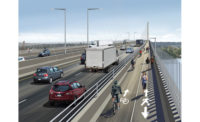The second phase of the Muddy River flood risk management construction is scheduled to begin in July following the award of a $36.5 million contract by the Army Corps of Engineers, New England District.
The Phase 2 construction project contract in Boston and Brookline, awarded to Charter Contracting Co. LLC of Boston, is expected to take three years to complete. The non-federal project sponsors are the Commonwealth of Massachusetts, the City of Boston and the Town of Brookline.
The project “exemplifies our company’s mission to safely and successfully execute complex, highly visible projects that positively impact the natural and built environment to benefit of the broader community,” says Bob Delhome, Charter president.
The overall $76-million Muddy River Flood Damage Reduction and Environmental Restoration project got underway 8 years ago in metropolitan Boston’s historic Emerald Necklace parks and waterways. The project’s $30.9-million Phase 1 broke ground in October 2012 in response to severe flooding of the Muddy River and its tributaries.
Jennifer Flanagan, project manager for the Corps’ New England District, Programs and Project Management Division in Concord, Mass. says work will be from Leverett Pond to Boylston Street in Boston and Brookline.
“The project scope of work consists of dredging 1 to 8 feet of sediment from the bottom of the river to construct the Flood Risk Management channel, stabilizing the material for transport, and trucking the material for disposal,” Flanagan says.
Phase 1 restored the original vision of designer Frederick Law Olmsted to a vital portion of the Emerald Necklace in the heart of Boston. Phase 2 involves excavating the Back Bay Fens and Riverway areas and five stretches of the Riverway section, the sandbar and island at Leverett Pond, and providing additional flood protection at the Boston Fire Department Fire Control Center in the Back Bay Fens.
Phragmites will be removed in the Back Bay Fens and Riverway areas to reduce flood damage and wetland vegetation will be replanted, in addition to landscaping with boulders and habitat logs for fish, turtles and amphibians.
Frances Allou Gershwin, the chair of the Muddy River Restoration Project Maintenance and Management Oversight Committee, says Phase 2 is “an excellent example of a green infrastructure project.“ She notes that it "really represents the re-engineering of Frederick Law Olmsted’s 19th century green infrastructure project called the Sanitary Improvement of the Muddy River.”



Post a comment to this article
Report Abusive Comment